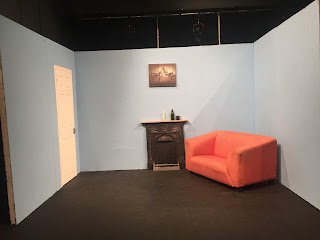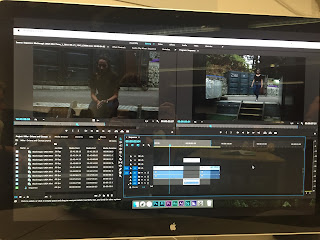Prelim Task Part 2
Whilst we were editing, one our teachers stopped us and reminded us that we should be editing the narrative and meaning of the film not just putting the shots that 'look cool' in. We then started to spend more time looking at a variety of shots before we edited them in to see which one would serve the narrative best and also suit the characters more. We wanted person 'B' to seem inferior to 'A' so we experimented with our high angle shots trying to see which shot would convey this to the
audience most.
 One of the issues that we had was with our actresses and the lines they had to recite. As, we didn't have a lot of time, the actresses had to learn their lines very quickly and unfortunately we had to cut some shots early because they forgot lines. We decided to write the lines on a piece of paper and stick it to the wall behind person 'B' so that she could read the liens if she forgot them. However, when we were editing we noticed that you can see her eyes moving on and off the paper trying to remember her lines and we didn't want the audience to notice because to would distract from the realism we were meant to be creating. We managed to find some shots where she doesn't look at the paper at all so we used them but we often had to cut them slightly earlier than we wanted. If we had the chance to repeat the task then I would hope to give the actresses their scripts earlier and filmed more shots rather than having to rush.
One of the issues that we had was with our actresses and the lines they had to recite. As, we didn't have a lot of time, the actresses had to learn their lines very quickly and unfortunately we had to cut some shots early because they forgot lines. We decided to write the lines on a piece of paper and stick it to the wall behind person 'B' so that she could read the liens if she forgot them. However, when we were editing we noticed that you can see her eyes moving on and off the paper trying to remember her lines and we didn't want the audience to notice because to would distract from the realism we were meant to be creating. We managed to find some shots where she doesn't look at the paper at all so we used them but we often had to cut them slightly earlier than we wanted. If we had the chance to repeat the task then I would hope to give the actresses their scripts earlier and filmed more shots rather than having to rush.Another issue that we had when editing was that we forgot the most important rule of all whilst editing, to save. Half way through our editing, the computer crashed resting in the loss of some of our work. When we got our computer back and running we realised that luckily we hadn't lost too much but it opened our eyes to the importance of editing because we could have lost all our work and if that happens with our thriller then it might have bad consequences.
Something that I really enjoyed with the editing was experimenting with shot durations and how that can effect how the audience perceive characters. In one edit we showed a lot more or person 'A' making her seem dominant and subconsciously causing the audience to associate themselves with her more than 'B'. In our other edit, we added a lot of reaction shots of person 'B' allowing the audience to sympathise with her more than 'A' and made 'A' seem like the antagonist. It was interesting to see that the person with the most screen time always seemed more important.
One of the conventions of thriller as a genre is fast paced editing so when it comes to creating our thriller we will have to make quite fast and short cuts to ensure that we acknowledge the typical elements within thrillers. In the prelim task, the scene was quite slow paced even though the scene was quite tense, so it may also be interesting to play around with shot duration and see if longer shots and occasional slow paced editing creates more tension than the typical past pace of thrillers.
When filming our prelim task I felt quite limited because we had to priorities the shots on the starboard leaving us less time to experiment with different shot types. When filming our thriller it will be different because we don't have the safety of a pre made story board, we'll have to create it ourselves allowing us to have the freedom to experiment with a range of shots. I think the editing for the thriller will be a lot harder than the prelim task because we will have to consolidate a soundtrack and other sound into it and overall it will be a lot longer. Every shot will have to be selected specifically to justify the codes and conventions of the thriller genre and will also have to create an idea as to what the entire film narrative would be. It will be hard but one thing that the prelim task showed me was that as a group we know everything we need to and are ready to try something more challenging.

















